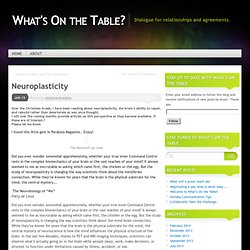

Www.genesis-sim.org/GENESIS/iBoG/iBoGpdf/chapt6.pdf. The Forgetting Pill Erases Painful Memories Forever. Photo: Dwight Eschliman Jeffrey Mitchell, a volunteer firefighter in the suburbs of Baltimore, came across the accident by chance: A car had smashed into a pickup truck loaded with metal pipes.

Mitchell tried to help, but he saw at once that he was too late. The car had rear-ended the truck at high speed, sending a pipe through the windshield and into the chest of the passenger—a young bride returning home from her wedding. There was blood everywhere, staining her white dress crimson. Mitchell couldn’t get the dead woman out of his mind; the tableau was stuck before his eyes. Pushing to remember a traumatic event soon after it occurs doesn’t unburden us—it reinforces the fear and stress.
Miraculously, that worked. In recent years, CISD has become exceedingly popular, used by the US Department of Defense, the Federal Emergency Management Agency, the Israeli army, the United Nations, and the American Red Cross. Mitchell was right about one thing, though. None of this is true. Upcommons.upc.edu/pfc/bitstream/2099.1/6277/6/4.NEURONA.pdf. Neuroplasticity. Mindfulness and Neuroplasticity. William James was one of the first psychologists to address the notion of neuroplasticity back in his late 19th century text, “The Principles of Psychology.”

The central idea behind neuroplasticity is that our brain can restructure itself based on our experience. One great example of neuroplasticity is sensory substitution. For instance, if a person is born blind, often the visual parts of the brain will be taken over by another sense, such as hearing or touch. This is the brain’s way of re-allocating unused processing power only to what we are actually experiencing. It would be wasteful to leave potential neural networks dormant simply because we aren’t getting any input from that sense.
Neuroplasticity occurs inside us everyday as we encounter new experiences. The more often neural pathways fire, the stronger the connections will become.
Neuroplasticity. Over the Christmas break, I have been reading about neuroplasticity, the brain’s ability to repair, and rebuild rather than deteriorate as was once thought.

I will over the coming months provide articles on this perspective as they become available. If these are of interest-? Please let me know. I found this little gem in Parabola Magazine.. Enjoy! The Neurocell up close Did you ever wonder somewhat apprehensively, whether your true inner Command Centre rests in the complex biomechanics of your brain or the vast reaches of your mind? The Neurobiology of “We”Patty de Llosa Did you ever wonder, somewhat apprehensively, whether your true inner Command Centre rests in the complex biomechanics of your brain or the vast reaches of your mind? The breakthrough in imaging techniques led Dr. On another front, the millennial inner science of meditation became the focus of experiments by Dr.
Relationships change the brain I asked Dr. “We is what me is!” “We can be both an ‘I’ and part of an ‘us’” 8 Ibid. La plasticidad cerebral, un buen predictor del éxito de la terapia. Para Hebbs la plasticidad es la capacidad que tiene el cerebro de conectarse con varias neuronas en una red. El cerebro posee millones de neuronas que todo el tiempo están haciendo sinapsis, las cuales nos permiten percibir el mundo de la forma en que lo hacemos.
Las sinapsis influyen en las emociones, conductas y pensamientos. Por lo tanto parte de lo que somos esta dado por nuestro funcionamiento neuronal. Lo interesante de la plasticidad es que se ha descubierto en los últimos años, que mientras mayor sea la conexión entre varias neuronas, las sinapsis se hacen más fuertes, es decir se potencializan. La potencialización es la fuerza de conexión que tienen las redes neuronales por estar correlacionadas en entre sí, entre mayores conexiones de neuronas y mayor estimulación a más receptores, estás conexiones se mantendrán activas a largo plazo. Por Psicóloga Adriana Fornasini Psicólogos Quito.